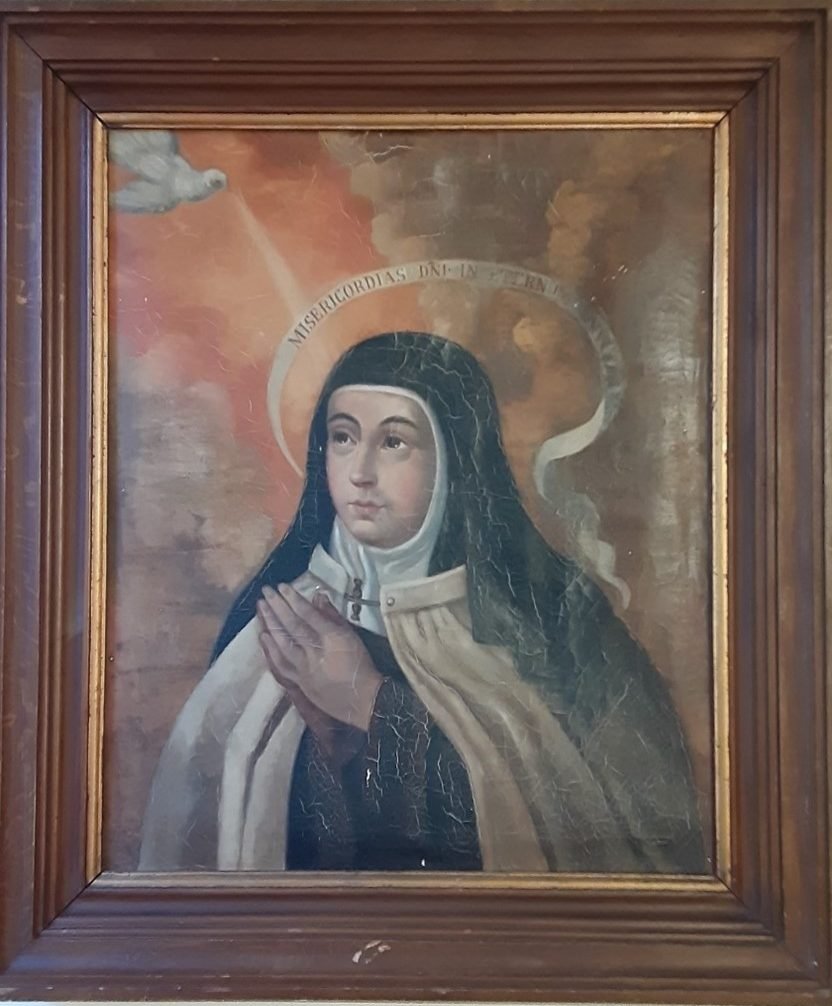Aunt Teresa of Jesus
Blessed feast day of St. Teresa of Jesus!
The image above shows a painting now gracing the ground floor elevator entrance in our Washington, DC monastery. It was given to the community by a friend of Carmel living in our area and a long-time devotee of Saint Teresa of Jesus. Fortunately for us, he found it on sale nearby when he recognized the saint depicted on it and the style it conveyed. Christopher Wilson could tell it was a copy of the very popular Brother Juan de la Miseria portrait done while Saint Teresa was still alive.
A word about Christopher first, then some other details about the portraiture work of Neopolitan Brother Juan de la Miseria will fill out this brief exercise in iconography à la Carmelitana.
Christopher was a member of the organizing team with Professor Barbara Mujica and me for a symposium held at Georgetown University back in 2004 commemorating the 400th anniversary of the arrival of the Discalced Carmelite nuns in France. After the symposium, he gladly assented to editing the conference papers and brought out the set of informative, sometimes fascinating, stories in a book in ICS Publications’ Carmelite Studies series (no. 9) about the first-generation followers of la Madre Teresa, The Heirs of St. Teresa of Avila: Defenders and Disseminators of the Founding Mother’s Legacy.
He left us the following description of the Teresa portrait when he delivered it to our house to be displayed on the wall where it now hangs:
The painting of Teresa (oil on canvas) was created in either Western Europe of Colonial Latin America, most likely 17th or 18th century, by an unidentified artist. The painting is based on Fray Juan de La Miseria’s 1576 portrait of Teresa, which is now in the Convent of Discalced Carmelite nuns in Alcalá de Henares [actually Seville], Spain. Fray Juan’s portrait was widely reproduced in engravings during the late sixteenth and seventeenth centuries, including frontispieces of early editions of Teresa’s books. The artist of the painting that I am donating likely used one of these engravings as his source. I purchased the painting at an antique store in Frederick, Maryland, c. 2005.
An example of a reproduction of Fray Juan’s portrait.
The painting is reminiscent of, inspired by, the original done by Brother Juan de la Miseria. He was repaid for his artistic efforts by the now legendary, and hilarious, reaction to them by Holy Mother Saint Teresa "God forgive you Fray Juan. You’ve made me ugly and blear-eyed!” (She would live for another six years.)
Less well known is another portrait by the Discalced brother artist of one of Teresa's close relatives, Teresita, her niece and daughter of her beloved brother Lorenzo.
He painted it at the same time and place as his Teresa portrait, soon after Teresita and her father landed at Seville, Spain in 1575 upon completion of Lorenzo’s civil service as Mayor of Quito, Ecuador. Teresita, by her own testimony in the cause for beatification of her aunt, was 8 years old. Why the religious habit she was wearing—artistic license? As sometimes occurred by exception, some young girls were allowed to enter a monastery in hopes of embracing afterward consecrated life. They were given garb resembling the habits of the professed nuns. They also received educational training from the community where they resided. Teresita made vows on November 9, 1582; and after a normal life as a Discalced nun died in the San Jose Carmel in Avila on September 10, 1610. Her saintly aunt wrote this about her in a letter from Burgos three months shortly before her own death: “Pray for Teresa, who is a little saint and has a great desire to be a professed nun. May God guide her. . .” (Letter 455, 6, July 6, 1582)
As Aunt Teresa entrusted her South American niece to God’s guidance, we thank the Lord for his guiding the hand of Brother Juan de la Miseria to transmit to us his lovely family-centered images agreed to by Saint Teresa herself while still alive. One is also grateful to Dr. Christopher Wilson for his thoughtful kindness to us.
Photography and text John Sullivan, o.c.d.




